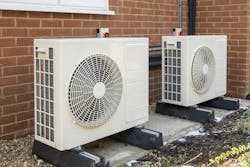What to Know About Air Source Heat Pumps and Cold Climates
There are several different ways to go about reducing greenhouse gas emissions, and it’s become increasingly important to consider different strategies as more local and state jurisdictions implement new regulations. One strategy to consider for home building is residential heating, says the National Association of Home Builders. One approach that comes with an incentive from the Department of Energy’s Energy, Emissions, and Equity Initiative is installing heat pumps. Air source heat pumps take energy from a cold place and push it toward a warmer place. When air flows through the air handler box, the heat exchange occurs.
To do this, the air flows through an air handler box where a heat exchange occurs. It also includes a compressor, which pumps a refrigerant fluid through a circuit, and moves heat around through compression, condensation, expansion and evaporation. The technology can typically move heat efficiently, so for each unit of energy that is put into the system, there could be up to five units of heat pushed out.
Heat pump technology is dependent on the outside air temperature; the larger the temperature difference between the outside and inside air, the bigger the “lift” and more difficult it is for the components to do their job. So in cold climates, it’s necessary to use heat exchangers that minimize the difference between the refrigerant temperature and outside air temperature. The larger the temperature lift, the higher the compression ratio, which causes the compressor component to use relatively more energy than the useful heat transferred by the technology.
New technology advances can improve performance of heat pumps in low and even sub-zero temperatures, though they tend to cost more (exact amounts depend on the local market) than traditional heat pump technology. Some cold climate techniques for heat pumps include:
- Incorporating an inverter drive into the compressor, also known as a variable-speed compressor. This allows the compressor component of the pump to adjust the flow of the refrigerant to compensate for the differences in temperature lift required throughout the day/night;
- Using vapor injection to cool the compressor to reduce the amount of energy used within the system;
- Switching the type of refrigerant used, as some refrigerants work better in colder climates than others; and
- Using oil injection technology for cooling during the compressor component.
